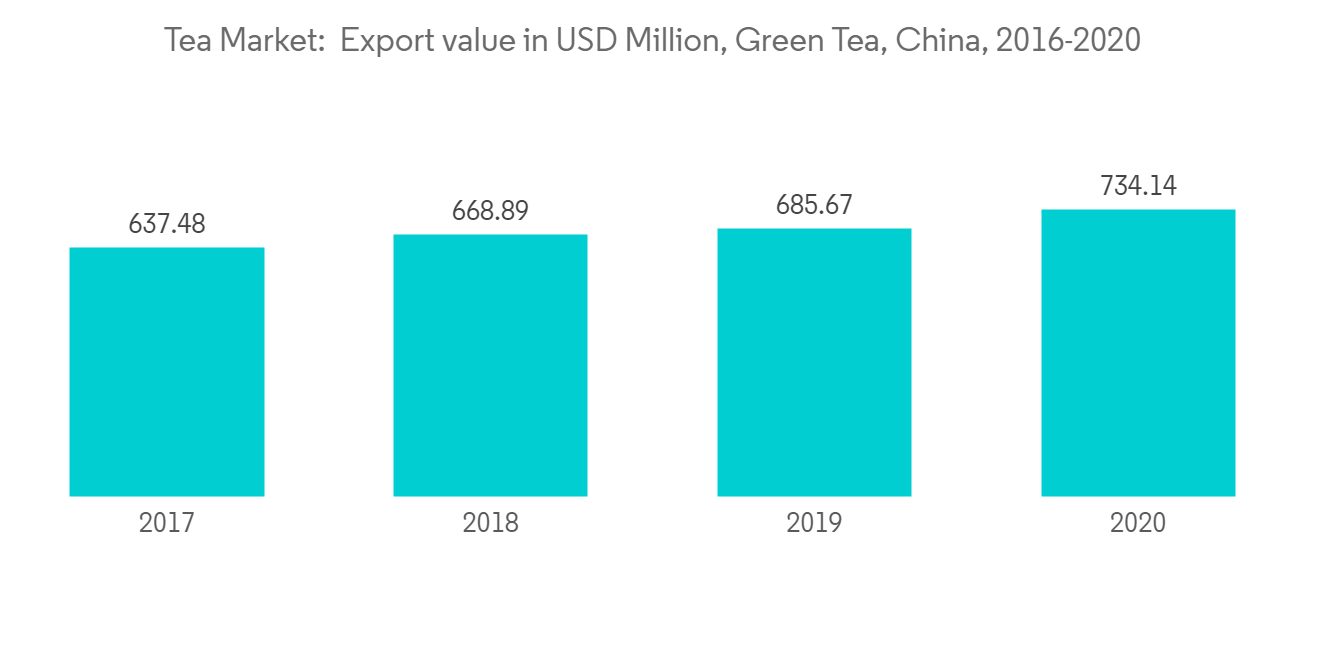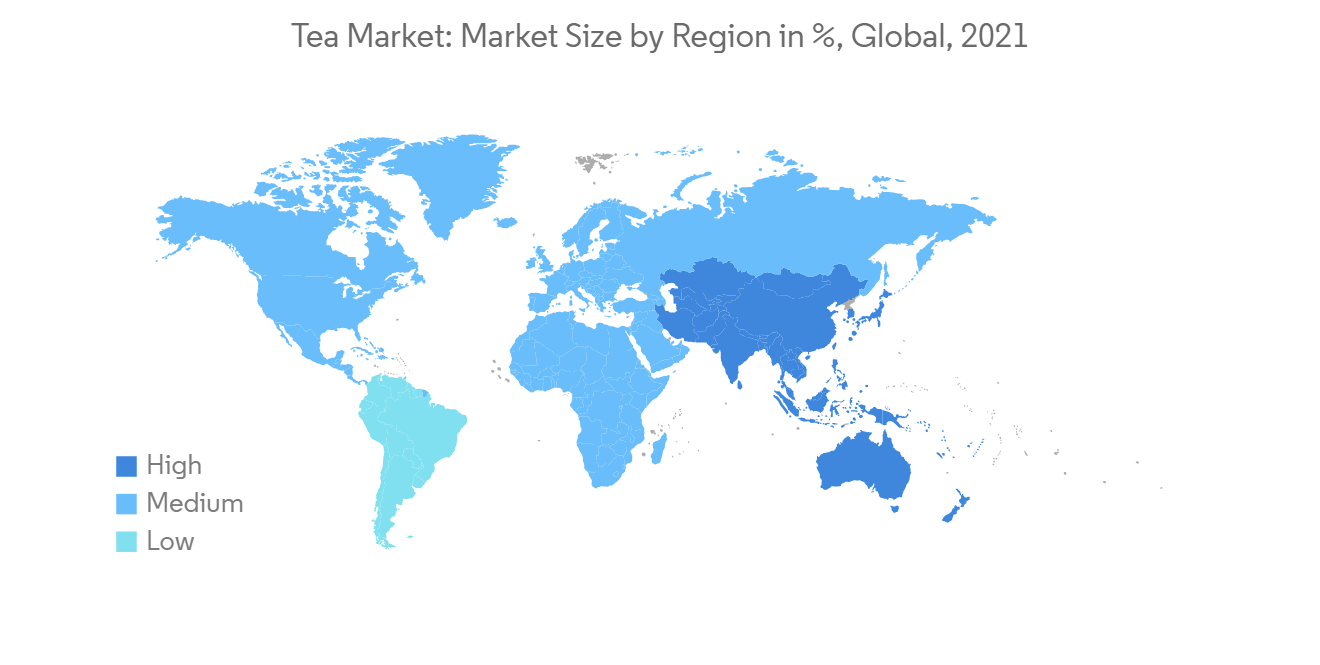 |
市場調查報告書
商品編碼
1237850
茶葉市場 - COVID-19 的增長、趨勢、影響和預測 (2023-2028)Tea Market - Growth, Trends, And Forecasts (2023 - 2028) |
||||||
※ 本網頁內容可能與最新版本有所差異。詳細情況請與我們聯繫。
在預測期內,茶葉市場預計將以 4.5% 的複合年增長率增長。
COVID-19 大流行對全球茶葉市場產生了直接的不利影響。 為控制和遏制大流行而採取的全球停擺措施對分銷渠道產生了不利影響。 分銷渠道的中斷也影響了增值活動並降低了成品的市場可用性。 茶產業是勞動密集型產業,需要大量勞動力來種植和加工茶葉。 與優質葉子的收穫高峰期相吻合的積極遏制公告對優質葉子的生產產生了影響。
茶葉市場的特點是紅茶行業佔比大。 然而,最大的增長將來自對綠茶和花草味茶的健康益處的認識。 中國是世界上最大的茶葉生產國,其次是印度、肯尼亞和斯裡蘭卡。 這是因為茶葉生產對氣候條件的變化高度敏感,而且茶葉只能在狹義的農業生態條件下生產。 中國居首位,約佔世界茶葉出口的31.8%。 此外,中國是綠茶的主要出口國。
亞太地區是調查中最大的區域部分。 每個國家的強勁經濟增長導致越來越多的中產階級消費者群體偏愛優質混合茶。 消費者正在將他們的購買範圍從未包裝的茶葉擴大到特種包裝和袋裝茶葉。 此外,碳酸飲料的消費成為茶行業的新趨勢,進一步拉動了茶葉市場的增長。 此外,Bigelow等茶葉製造商推出了從果香到草本香的各種口味的茶,為消費者提供了多樣化的茶產品陣容。
茶葉市場趨勢
對草藥和綠茶的興趣增加
消費者對花草茶和綠茶的健康益處的認識可能會進一步推動茶葉市場的增長。 消費者可支配收入的增加、口味和偏好的變化以及各種市場參與者在茶中額外引入健康成分是推動市場增長的其他因素。 預計茶葉的便捷供應將推動亞太地區綠茶市場的增長。 全球綠茶產量預計將以比紅茶更快的速度增長,這反映了中國的增長。 此外,千禧一代對茶的消費也在增加,推動茶學校和茶藝培訓,在各地舉辦茶博會和茶藝活動,成為千禧一代的主要產品。 隨著全球消費的擴大,中國綠茶出口穩步增長。 根據 ITC Trade 的數據,2020 年中國 3 公斤或以下包裝的綠茶出口價值約為 7.341 億美元,而 2017 年為 6.485 億美元。 因此,全球不斷增長的需求可能會推動市場發展多年。

亞太地區引領茶葉市場
目前,茶葉消費量的增長受到人均收入快速增長的推動,尤其是在亞太地區的新興經濟體中。 進入中產階級的年輕且日益城市化的人口已準備好消費更多併購買優質茶產品。 因此,這些變化有可能演變成更強大、更持久的趨勢。 目前,亞太地區是最大的茶葉消費市場,中國、印度等新興國家經濟增長強勁。 正因如此,不少中產消費者偏愛優質拼配茶和品牌茶,越來越多地從散裝茶升級為特製茶葉包裝和袋裝。

茶葉市場競爭者分析
其他福利。
- Excel 格式的市場預測 (ME) 表
- 3 個月的分析師支持
內容
第一章介紹
- 調查先決條件和市場定義
- 調查範圍
第二章研究方法論
第 3 章執行摘要
第四章市場動態
- 市場概覽
- 市場驅動因素
- 市場製約因素
- 價值鏈分析
- 價值鏈摘要
- 價值鏈中的加價
- 價值鏈問題
第 5 章市場細分
- 類型
- 紅茶
- 綠茶
- 專業
- 發酵茶
- 其他類型
- 地區(生產量分析:量,消費量分析:量和值,進口量分析:量和值,出口量分析:量和值,價格趨勢)
- 北美
- 美國
- 加拿大
- 歐洲
- 俄羅斯
- 波蘭
- 英國
- 德國
- 愛爾蘭
- 亞太地區
- 中國
- 印度
- 哈薩克斯坦
- 斯裡蘭卡
- 越南
- 日本
- 印度尼西亞
- 南美洲
- 巴西
- 阿根廷
- 智利
- 中東和非洲
- 沙特阿拉伯
- 阿拉伯聯合酋長國
- 尼日利亞
- 南非
- 肯尼亞
- 土耳其
- 北美
第六章市場機會與未來趨勢
第 7 章評估 COVID-19 的市場影響
The tea market is projected to register a CAGR of 4.5% during the forecast period.
The COVID-19 pandemic had a direct and unfavorable impact on the tea market globally. Global lockdowns to curb and contain the pandemic adversely affected the distribution channels. Value addition activities were affected due to disrupted distribution channels, which lowered the availability of end products in the market. The tea industry is a labor-intensive industry that has more labor involved in the process of growing and processing tea. The announcement of aggressive containments that coincided with the peak harvesting periods for quality tea leaves had affected the production of quality tea.
The tea market is characterized by the black tea segment holding a prominent share. However, the maximum growth is estimated for green and herbal/flavored tea due to the awareness of the health benefits associated with them. China is the largest producer of tea in the world, followed by India, Kenya, Sri Lanka, and others. Tea production is highly sensitive to changes in climatic conditions, as tea can only be produced in narrowly defined agro-ecological conditions. China ranks first in the global tea exports, representing approximately 31.8% of the global export of tea. China is also the leading green tea exporter.
Asia-Pacific was the largest geographic segment of the market studied. The robust economic growth in the countries has also created a large consumer base among middle-class groups with a preference for premium tea blends. Consumers are frequently enhancing their purchases from unpackaged tea to packed and bagged specialty varieties. Furthermore, the consumption of carbonated tea drinks is a new trend in the tea industry, which is further fuelling the growth of the tea market. Various tea manufacturing companies, such as Bigelow, have introduced several flavors of tea, ranging from fruity to herbal flavors, creating a diversified portfolio of tea products for customers.
Tea Market Trends
Increasing Inclination Toward Herbal and Green Tea
Consumer awareness about the health benefits of herbal and green tea may further drive the growth of the tea market. The rise in disposable income of consumers, changes in taste and preferences, and the introduction of additional healthy ingredients in tea by different market players are the other factors that fuel the market growth. The easy availability of tea is expected to encourage the growth of the Asia-Pacific green tea market. World green tea production is expected to grow at a faster rate than black tea, reflecting the growth in China. The millennials are also increasing their tea consumption, led by the promotion of tea schools and tea art training and the staging of tea expos and tea events all over the country, making it a flagship product among millennials. Owing to the increased consumption across the world, China's export of green tea has been recording steady growth. According to the ITC Trade, China's green tea export of packages lesser than or equal to 3 kg packing was valued at around USD 734.1 million in 2020 compared to USD 648.5 million in 2017. Hence, the increasing demand around the world may drive the market over the years.

Asia-Pacific is Leading the Tea Market
Currently, the growth in tea consumption is being driven by rapid growth in per capita incomes, particularly in the developing countries of Asia-Pacific. A growing, increasingly urban young population segment entering the middle class is prepared to consume more and pay for premium tea products. Therefore, these changes have the potential to develop into stronger and longer trends. At present, Asia-Pacific has the largest market for tea consumption, with robust economic growth in a number of developing countries, such as China and India. This has created a large middle-class group, with a preference for premium tea blends and brands, often upgrading their purchases from unpackaged tea to packed and bagged specialty varieties.

Tea Market Competitor Analysis
Additional Benefits:
- The market estimate (ME) sheet in Excel format
- 3 months of analyst support
TABLE OF CONTENTS
1 INTRODUCTION
- 1.1 Study Assumptions and Market definition
- 1.2 Scope of the Study
2 RESEARCH METHODOLOGY
3 EXECUTIVE SUMMARY
4 MARKET DYNAMICS
- 4.1 Market Overview
- 4.2 Market Drivers
- 4.3 Market Restraints
- 4.4 Value Chain Analysis
- 4.4.1 Value Chain Overview
- 4.4.2 Price Markups in the Value Chain
- 4.4.3 Value Chain Issues and Challenges
5 MARKET SEGMENTATION
- 5.1 Type
- 5.1.1 Black Tea
- 5.1.2 Green Tea
- 5.1.3 Specialty Teas
- 5.1.4 Fermented Tea
- 5.1.5 Other Types
- 5.2 Geography (Production Analysis in Volume, Consumption Analysis by Volume and Value, Import Analysis by Value and Volume, Export Analysis by Value and Volume, and Price Trend Analysis)
- 5.2.1 North America
- 5.2.1.1 United States
- 5.2.1.2 Canada
- 5.2.2 Europe
- 5.2.2.1 Russia
- 5.2.2.2 Poland
- 5.2.2.3 United Kingdom
- 5.2.2.4 Germany
- 5.2.2.5 Ireland
- 5.2.3 Asia-Pacific
- 5.2.3.1 China
- 5.2.3.2 India
- 5.2.3.3 Kazakhstan
- 5.2.3.4 Srilanka
- 5.2.3.5 Vietnam
- 5.2.3.6 Japan
- 5.2.3.7 Indonesia
- 5.2.4 South America
- 5.2.4.1 Brazil
- 5.2.4.2 Argentina
- 5.2.4.3 Chile
- 5.2.5 Middle-East and Africa
- 5.2.5.1 Saudi Arabia
- 5.2.5.2 United Arab Emirates
- 5.2.5.3 Nigeria
- 5.2.5.4 South Africa
- 5.2.5.5 Kenya
- 5.2.5.6 Turkey
- 5.2.1 North America













